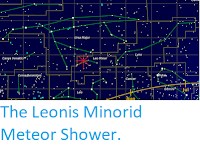Witnesses across Britain and Ireland have
reported witnessing a
fireball meteor slightly before 8.00 pm local time (slightly before 7.00 pm GMT) on Monday 28 October 2019. The
majority of sightings came from Ireland,
but with many sightings In Wales, Scotland and northern England. A
fireball
is defined
as a meteor
(shooting star) brighter than the
planet Venus. These are typically caused by pieces of rock burning up in
the atmosphere, but can be the result of man-made space-junk burning up
on re-entry. On this occasion many reports stated that the meteor was green, suggesting that the meteor had a high magnesium or nickel content, and moving southeast to northwest, first entering the atmosphere over the Celtic Sea and disappearing somewhere over County Cork.
Fireball meteor seen from outside Banteer in County Cork on 28 October 2019. Sean Linehan/Irish Independent.
Objects
of this size probably enter the Earth's atmosphere several times a
year, though unless they do so over populated areas they are unlikely to
be noticed. They are officially described as fireballs if they produce a
light brighter than the planet Venus. The brightness of a meteor is caused by friction with
the Earth's atmosphere, which is typically far greater than that caused
by simple falling, due to the initial trajectory of the object. Such
objects typically eventually explode in an airburst called by the
friction, causing them to vanish as an luminous object. However this is
not the end of the story as such explosions result in the production of a
number of smaller objects, which fall to the ground under the influence
of gravity (which does not cause the luminescence associated with
friction-induced heating).
Map
showing areas where sightings of the meteor were reported, and the
apparent path of the object (blue arrow). American Meteor Society.
These 'dark objects' do not continue along the path
of the original bolide, but neither do they fall directly to the ground,
but rather follow a course determined by the atmospheric currents
(winds) through which the objects pass. Scientists are able to calculate potential trajectories for hypothetical dark
objects derived from meteors using data from weather monitoring services.
See also...
Follow Sciency Thoughts on Facebook.








